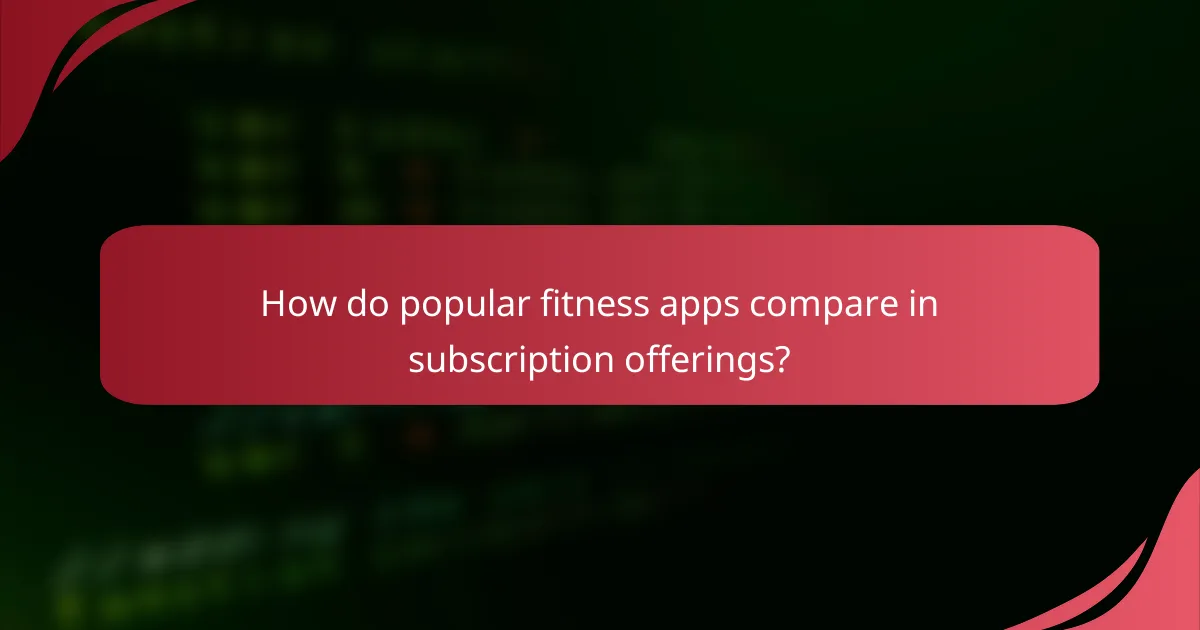As the fitness app market continues to grow, understanding the various subscription models is crucial for users seeking the best value. With options like monthly, annual, freemium, and pay-per-class, each model presents distinct advantages that cater to different fitness goals and budgets. Popular apps such as Peloton, MyFitnessPal, and Fitbit Premium showcase diverse features and pricing structures, making it essential to assess which subscription aligns best with individual preferences and usage patterns.

Which fitness app subscription models provide the best value?
Fitness app subscription models vary widely, and the best value often depends on individual preferences and usage patterns. Monthly, annual, freemium, and pay-per-class options each have unique benefits and drawbacks that can influence overall cost-effectiveness.
Monthly subscriptions
Monthly subscriptions offer flexibility, allowing users to pay for access on a short-term basis. This model is ideal for those who want to try an app without a long-term commitment or who may only use it seasonally.
However, monthly fees can add up quickly, often ranging from $10 to $30 per month. If you plan to use the app consistently, this model may not provide the best long-term value compared to annual subscriptions.
Annual subscriptions
Annual subscriptions typically offer a discounted rate compared to monthly payments, making them a cost-effective option for regular users. Prices can vary, but many apps charge between $60 and $180 per year, which can save users a significant amount over time.
Choosing an annual plan is beneficial if you are committed to a fitness routine and plan to use the app regularly. Just be cautious of cancellation policies, as some apps may have strict terms regarding refunds or early termination.
Freemium models
Freemium models provide basic access to fitness app features at no cost, with the option to upgrade for premium content. This approach allows users to explore the app and determine its value before committing financially.
While freemium apps can be appealing, they often limit access to essential features, which may hinder your fitness goals. Consider whether the premium features justify the cost before upgrading, and look for apps that offer a trial period for premium access.
Pay-per-class options
Pay-per-class options allow users to pay only for the classes they attend, which can be ideal for those who prefer variety or have unpredictable schedules. This model typically charges between $5 and $20 per class, depending on the app and type of workout.
This approach can be economical for occasional users but may become expensive for those who attend classes frequently. Evaluate your workout habits to determine if this model aligns with your fitness goals and budget.

How do popular fitness apps compare in subscription offerings?
Popular fitness apps like Peloton, MyFitnessPal, and Fitbit Premium offer a range of subscription models that cater to different user needs. Each app provides unique features and pricing structures, making it essential to evaluate which offers the most value based on personal fitness goals and budget.
Peloton subscription benefits
Peloton offers a subscription model that provides access to live and on-demand classes across various workout types, including cycling, running, strength training, and yoga. The subscription typically costs around $40 per month, allowing users to join a community and track their progress through the app.
Key benefits include the ability to participate in interactive classes led by professional instructors, personalized workout recommendations, and a leaderboard feature that fosters competition. Users can also access specialized programs and challenges, enhancing motivation and engagement.
MyFitnessPal pricing structure
MyFitnessPal operates on a freemium model, offering a basic version for free while the premium subscription costs approximately $20 per month or $80 annually. The premium version includes advanced features such as food analysis, custom goals, and an ad-free experience.
Consider the premium subscription if you want detailed nutritional insights and the ability to track macronutrients more effectively. The app’s extensive food database and barcode scanning feature make it easier to log meals, which can be particularly beneficial for those focused on weight management.
Fitbit Premium features
Fitbit Premium is available for around $10 per month or $80 annually and offers personalized health insights, guided programs, and advanced sleep tracking. Subscribers can access exclusive workouts and wellness content tailored to their fitness levels and goals.
One of the standout features is the health metrics dashboard, which provides users with insights into their overall wellness, including stress management and sleep quality. This holistic approach can help users make informed decisions about their fitness and health routines.

What are the key features of fitness app subscriptions?
Fitness app subscriptions typically offer a range of features designed to enhance user experience and effectiveness. Key features include workout variety, personalized coaching, and community support, all of which contribute to a more engaging and motivating fitness journey.
Workout variety
Workout variety is essential for maintaining user interest and preventing plateaus. Many fitness apps provide diverse workout options, including strength training, cardio, yoga, and high-intensity interval training (HIIT). Users should look for apps that regularly update their workout libraries to keep routines fresh.
Consider apps that offer customizable workout plans based on fitness levels and goals. For example, some platforms allow users to select beginner, intermediate, or advanced workouts, ensuring that the exercises remain challenging yet achievable.
Personalized coaching
Personalized coaching can significantly enhance the effectiveness of fitness app subscriptions. Many apps offer tailored workout plans and nutrition advice based on individual user data, such as fitness goals, preferences, and progress. This customization helps users stay on track and achieve their objectives more efficiently.
Some fitness apps provide access to certified trainers for one-on-one coaching sessions, either through video calls or messaging. This feature can be particularly beneficial for users seeking accountability and expert guidance in their fitness journey.
Community support
Community support is a vital feature of many fitness app subscriptions, fostering motivation and accountability among users. Many apps include social features, such as forums, challenges, and leaderboards, allowing users to connect with others pursuing similar fitness goals.
Engaging with a community can enhance the overall experience, as users can share tips, celebrate achievements, and provide encouragement. Look for apps that facilitate interaction, such as group challenges or social media integration, to maximize the benefits of community support.

What factors should you consider when choosing a fitness app subscription?
When selecting a fitness app subscription, consider your budget, fitness goals, and the user interface. These factors will help you find an app that aligns with your needs and enhances your workout experience.
Budget constraints
Your budget is a crucial factor when choosing a fitness app subscription. Prices can range from free options with limited features to premium subscriptions costing around $10 to $30 per month. Evaluate what you can afford and whether the app’s offerings justify the expense.
Look for apps that provide a free trial or a money-back guarantee. This allows you to test the app’s features without financial commitment, ensuring it meets your expectations before you invest.
Fitness goals
Define your fitness goals clearly, as different apps cater to various objectives. Whether you aim to lose weight, build muscle, or improve endurance, select an app that offers tailored programs and resources to support your specific aims.
For example, if your goal is weight loss, look for apps that include meal planning and calorie tracking features. If building strength is your focus, choose an app that offers resistance training programs and progress tracking.
User interface
The user interface of a fitness app significantly impacts your overall experience. An intuitive and easy-to-navigate design can enhance your motivation and adherence to your fitness routine. Consider how the app organizes workouts, tracks progress, and provides feedback.
Before committing, explore user reviews and ratings to gauge the interface’s usability. A well-designed app should allow you to quickly access workouts, log activities, and monitor your progress without frustration.

How do user reviews influence fitness app subscription choices?
User reviews significantly impact fitness app subscription decisions by providing potential users with insights into the app’s effectiveness, usability, and overall value. Positive ratings can enhance credibility, while negative feedback may deter users from committing to a subscription.
Impact of ratings on decisions
Ratings play a crucial role in shaping user perceptions and choices regarding fitness app subscriptions. Apps with higher ratings, typically above four stars, are more likely to attract new subscribers, as users often equate higher ratings with better quality and reliability.
Conversely, apps with low ratings can struggle to gain traction, even if they offer unique features. Users often read reviews to gauge the experiences of others, making it essential for app developers to maintain a positive rating to encourage subscriptions.
Common user feedback themes
User feedback often highlights themes such as app functionality, customer support, and content variety. Many users appreciate apps that offer diverse workout options and easy navigation, which can lead to higher satisfaction and retention rates.
Another common theme is the responsiveness of customer support. Users value prompt assistance when encountering issues, and positive experiences in this area can significantly influence their decision to subscribe. Additionally, users frequently comment on the pricing structure, with many seeking value for money in their subscriptions.

What are the emerging trends in fitness app subscriptions?
Emerging trends in fitness app subscriptions include increased integration with wearable devices, personalized training programs, and a focus on community engagement. These trends reflect a shift towards more holistic and user-centric approaches that enhance the overall fitness experience.
Integration with wearables
Integration with wearables is becoming a standard feature in many fitness app subscriptions, allowing users to track their workouts and health metrics seamlessly. This connectivity enables apps to provide real-time feedback and personalized recommendations based on data collected from devices like smartwatches and fitness trackers.
When choosing a fitness app, consider how well it integrates with your existing wearables. Look for apps that support a variety of devices, such as Fitbit, Apple Watch, or Garmin, to ensure compatibility. Some apps may even offer exclusive features for specific devices, enhancing the value of your subscription.
Be cautious of apps that require additional purchases for full functionality with wearables. Always check if the subscription includes access to all features or if there are hidden costs associated with syncing data from your devices.


